October 22, 2010
Air Date: October 22, 2010
FULL SHOW
SEGMENTS
Aviation and Emissions
View the page for this story
After a ten-year stalemate, the UN group in charge of combating greenhouse gas emissions from airplanes came to an agreement on how to do just that. Airline trade groups are calling the decision historic. But some environmental groups think the resolution doesn’t go far enough. Host Bruce Gellerman talks with Sarah Burt, an attorney with the law firm Earthjustice, about the scope of the resolution. (05:15)
What’s Eating Lake Erie?
/ Julie GrantView the page for this story
Blue green slime is choking western Lake Erie. Beaches have had swim advisories for most of the summer, water treatment systems were clogged, and the toxic algae is being blamed for a drop in walleye fish. Julie Grant reports from Ohio on what’s causing the algae and how it’s affecting tourism. (06:10)
Science Note/Saved By a Whisker
/ Amanda MartinezView the page for this story
Scientists recently showed that it’s possible to prevent strokes in rats by stimulating a single whisker for four minutes. As Amanda Martinez reports, if humans respond similarly, future stroke treatment could be as simple as massaging one’s fingertips. (02:00)
Genetics and the Environment
View the page for this story
There’s been a paradigm shift in the field of genetics. Instead of relying solely on DNA and inheritance, the field of epigenetics now demonstrates how environmental factors can also determine diseases in our future, and in our children and grandchildren’s future. Host Bruce Gellerman talks with epigeneticist Michael Skinner, a professor at Washington State University. (06:10)
Don’t Be Such a Scientist
View the page for this story
Marine biologist-turned- filmmaker Randy Olson thinks scientists could learn a thing or two from an unlikely source: Hollywood. In his new book, “Don’t Be Such A Scientist,” Olson looks at how scientists aren’t keeping up with today’s quick communication, and says a lesson in Hollywood style storytelling could be the solution. He spoke with Living On Earth’s Jeff Young about how he sees this disconnect playing out in current events. (06:40)
Still Life
/ Verlyn KlinkenborgView the page for this story
Sometimes time seems to stand still. But soon enough, as commentator Verlyn Klinkenborg notes, the clock resumes ticking and the weather changes, marking the change of seasons. (02:30)
Giant Walmart Thinks Small
View the page for this story
Walmart recently announced plans to get more of its food from local sources and small to mid-sized farms. To learn what's in it for the big box retailer, host Bruce Gellerman talks to Michelle Harvey who leads Environmental Defense Fund's partnership with Walmart. LOE also reaped opinions from growers at a Massachusetts farmers’ market who are skeptical of the plan. (09:30)
Creating a Thatched Roof
/ Bruce GellermanView the page for this story
One of the world's oldest building materials is being used to transform a 1950's suburban ranch into an Irish country cottage. Host Bruce Gellerman meets a master thatcher at work as he turns a field of reeds into a roof. (06:00)
This week's EarthEar selection
listen /
download
On a cold October eve in Scotland, Red Deer stags roar to let the females know it's mating season.
Show Credits and Funders
Show Transcript
HOST: Bruce Gellerman
GUESTS: Sarah Burt, Michael Skinner, Randy Olson, Verlyn Klinkenborg, Michelle Harvey, Keith Malcolm Brown, Colin McGee
REPORTERS: Julie Grant, Jeff Young
NOTES: Amanda Martinez
[THEME]
GELLERMAN: From Public Radio International, this is Living on Earth. I’m Bruce Gellerman. Walmart tries to help small farmers globally by buying more locally, but some small growers say it’s a raw deal.
[THEME]
KIMBALL: I think it’s better for consumers to go directly to the farms and to develop a relationship with the farmers. I think if people go to Walmart they’re losing that farm-to-table connection. I think that’s a sad thing.
GELLERMAN: Also, a green slime gums up Lake Erie, worrying scientists and fishermen.
PACHOLSKI: The algae was actually probably the worst I have seen it in the 27 years I have been doing this- by August it was horrendous.
GELLERMAN: And reaping a roof from fields of reeds.
BROWN: This is the largest private residence that has a thatch roof in New England. There's about 15 acres of reed on this roof.
GELLERMAN: These stories, and more, this week on Living on Earth. Stick with us!
[THEME]
Aviation and Emissions

The water vapor in airplane contrails acts as a greenhouse gas. (Photo: Flickr CC Francois Roche)
GELLERMAN: From the Jennifer and Ted Stanley Studios in Somerville, Massachusetts this is Living on Earth. I’m Bruce Gellerman. Next month, thousands of diplomats, journalists, and environmentalists from around the world will fly to Cancun, Mexico for another round of UN climate change negotiations. Ironically, the greenhouse gases from all that air travel is not one of the topics they’ll be discussing.
The UN gave the responsibility for airplane emissions to the ICAO, the International Civil Aviation Organization. The group met recently in Montreal to discuss climate change emissions from planes and, after a decade long impasse, they came up with an agreement. Some are calling it an historic agreement. Sarah Burt is an attorney with the environmental law firm Earthjustice, specializing in international transportation and climate change issues.
BURT: The problem is really that aviation is responsible for a significant and growing percentage of global emissions of greenhouse gasses. It’s about two percent of global emissions of CO2 equivalent, so all gasses that are greenhouse gasses. But, when you take into account the fact that these emissions are at high altitude, and the fact that aircrafts also emit other non-greenhouse gasses like water vapor which are aircraft contrails, the impact of those emissions at altitude has a magnifying effect, and so they’re really responsible for about three to three and a half percent of global climate change.
GELLERMAN: And, there’s more people flying in more airplanes to more places.
BURT: That’s right, aviation growing really very rapidly, both domestic aviation and international aviation. In fact, international aviation is supposed to just about double in the next 25 to 30 years, so that’s a significant increase in the number of planes there are up in the skies.
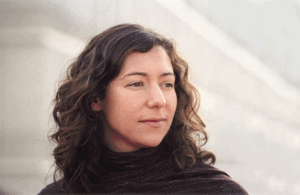
Sarah Burt is an attorney for the environmental law firm Earthjustice. (Earthjustice)
GELLERMAN: But aren’t airplanes supposedly becoming more fuel efficient?
BURT: Well, they’re not there yet. The airlines will tell you that they are doing all they can, trying to maximize their fuel efficiency. In fact, there is a lot that still remains to be done. For example, we use, in the United States, a ground based navigation system, which means that aircraft actually have to zigzag across the sky they have to lower their altitude to make contact with navigation systems on the ground and then go back to higher altitude again. Whereas if we had a satellite-based navigation system, they’d be able to fly at a more constant altitude, which would be much more efficient.
GELLERMAN: Well now the international civil aviation organization, this ICAO, says they’ve come up with an agreement. They have a solution, right?
BURT: They have come up with an agreement. A lot of the details of that agreement are still to be worked out. But, what has tentatively been agreed to is a cap of emissions from aviation at 2020 levels. And then also a two percent per year efficiency gain from 2020 until 2050.
GELLERMAN: So, they’ve come up with this agreement. These seem like ambitious goals. I mean, you’ve got two percent more efficiency per year, but when all is said and done, is there more going to be said than done, because it’s ten years out?
BURT: Well, the fact that an agreement was reached is significant. It means that globally the international community is onboard with addressing emissions from aviation. The details of the agreement really are not so ambitious. It’s true that they have agreed to a two percent efficiency gains per year, but when you compare that to the fact that industry growth is projected to be at about three to five percent per year, you can see that those efficiency gains are far outstripped by growth in the number of aircraft that are going to be out there. And also, it means carrying on business as usual for the next ten years in terms of flying old planes and using inefficient engines. Really the agreement reflects what the industry sees as being feasible and not too economically costly, rather than what the science and engineers say is not only possible but necessary in order to have a significant impact on emissions reductions from aviation.

The water vapor in airplane contrails acts as a greenhouse gas. (Photo: Flickr CC Francois Roche)
GELLERMAN: Virgin Atlantic has been pioneering use of bio-fuels, and I was just reading that British Airways and Airbus, the airplane manufacturer, have been developing a system to grow algae in their airports in these vast vats, and they expect that within four years to be flying their airplanes on algae- pond scum!
BURT: Yes, it’s exciting! And it sounds sort of somewhat out there, using pond scum as a fuel, but algae-based fuels have a lot of promise for an alternative fuel source to fossil fuels that can be used in aviation, as fuels for other things as well, like cars and ships. So, it seems like a promising technology.
GELLERMAN: At the end of November, I’m actually going to be flying to Mexico to go to the international UN climate conference, and I’m wondering, um, should I feel guilty about flying there?
BURT: I’m not sure guilt is particularly useful, but I think that you should certainly be aware of what the impact of those actions are. Not that we should never jump in a plane, but we should encourage measures to reduce the impact of those choices that we make.
GELLERMAN: Well Ms. Burt, thank you very much.
BURT: Thank you.
GELLERMAN: Sarah Burt is an attorney with the law firm EarthJustice.
Related links:
- The International Civil Aviation Organization (ICAO)
- Earth Justice
[MUSIC: Groove Collective “The Great Escape” from Live and Hard To Find (Kufala Records 2006)]
What’s Eating Lake Erie?
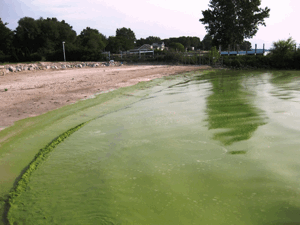
This past summer, swimmers stayed away from these algae-tainted waters. (Photo: Tom Bridgeman, University of Toledo.)
GELLERMAN: By surface area, the Great Lakes comprise the largest body of fresh water in the world. But for the past few years a green toxic algae has been blooming in one of the Great Lakes – Lake Erie. And this past summer, the green glop has been growing out of control; threatening wildlife, swimmers and drinking water supplies. As Julie Grant reports from Ohio, scientists now say it’s just one of a number of toxic algae threatening the lake.
[WIND SOUNDS]
GRANT: It’s a windy day along the Lake Erie shoreline in western Ohio. Captain Paul Pacholski doesn’t want to battle the big waves, so he meets me inside the Lake Erie Research Center, which overlooks the water. Pacholski started a charter boat business with his father in the early 1980s. This has been one of their toughest years, because the lake is filled with algae.
PACHOLSKI: Algae was probably the worst I have seen it in the 27 years I have been doing this. It started developing probably in the middle of June, where you normally don’t see it until July. And by August it was horrendous.
GRANT: Pacholski says the pea green florescent slime made it look like his boat was moving through paint. His customers would ask ‘what’s up with the water?’ He tried to brush the algae off as no big deal. But he wouldn’t take them to his regular fishing spots – it was embarrassing.
PACHOLSKI: You would not want to stop and take customers from another state such as Wisconsin or Illinois and stop them in that water and have them look at that green broth and just know that our lake is starting to get sick.
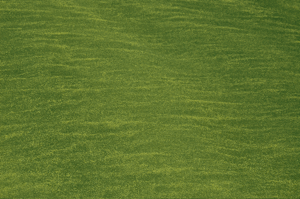
From sea to shining sea of green algae. (Photo: Tom Bridgeman, University of Toledo.)
GRANT: Pacholski says the algae cost him and other charter boat captains more than ten percent of their business this year, and he’s worried about the future of fishing here. The shallow water makes the western basin the best nursery grounds in Lake Erie for Walleye, Perch and Whitefish. These fish are the backbone of the Lake’s billion dollar fishing industry. The Ohio Department of Natural Resources says the number of Walleye have dropped from 80-million down to 20-million over the past five years. Officials and some scientists suspect it’s due to the algae.
[SOUND OF WAVES]
GRANT: Tom Bridgeman stands on the western Lake Erie Shore. He’s an environmental studies professor at the University of Toledo. And has studied microysitis and lynbia algae since 2003.
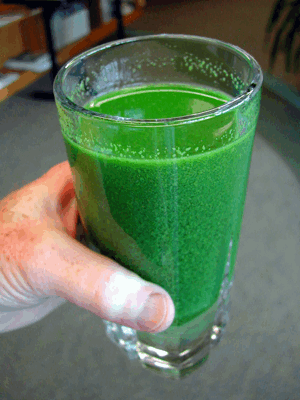
You wouldn’t want to drink this glass of microcystis. (Photo: Tom Bridgeman, University of Toledo.)
BRIDGEMAN: You see this dark-green blackish stringy looking algae, and then you see a bright green, almost florescent green scum of algae, and those are the two different kinds.
GRANT: These toxic algae have encroached on Lake Erie for seven years now. But this year it hit where people noticed: along the shorelines, in the tourist areas. Beaches were under swimming advisories most of the summer… Bridgeman says most types of algae are good for the food chain in a Lake. But this recent algae can be dangerous to people.
BRIDGEMAN: The problem with it is that it produced a toxin. And that toxin can damage the liver if it’s ingested and can cause skin rashes in some people.
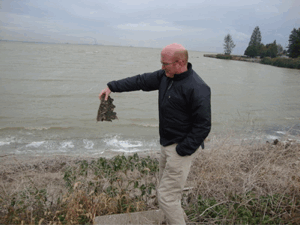
Scientist Tom Bridgeman holds a piece of lynbia. (Photo: Julie Grant)
[SOUND OF WAVES.]
GRANT: We stand on a four-foot high pile of dried algae that runs along the beach. Bridgeman says this variety is called Lynbia, and it forms what looks like a thick mat of hair along the bottom of the lake. Lynbia consumes oxygen and could cause hypoxia, suffocating fish and other organisms on the bottom of the Lake. In the past few years, Lynbia has piled on the shorelines as the weather cools in the fall.
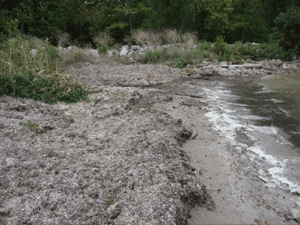
The toxic algae, lynbia, piles on the western shore of Lake Erie. (Photo: Julie Grant)
BRIDGEMAN: And when conditions are right, and the algae breaks loose from the bottom, there will be another layer of algae deposited right where we’re standing.
GRANT: The algae feed on excess nutrients in the water, especially phosphorous, from agriculture and sewage. Bridgeman remembers when Lake Erie was known as a dirty, dead lake in the 1970s. But in the wake of the Clean Water Act water quality improved. Industrial pollution was largely cut off and fish populations rebounded. There was a renaissance in tourism and fishing in the ‘80s and early ‘90s.

This past summer, swimmers stayed away from these algae-tainted waters. (Photo: Tom Bridgeman, University of Toledo.)
But in the mid 1990s, algae blooms started appearing. The EPA focused on sewer systems. In many cities such as Toledo and Detroit, the sewers can’t handle big rain events, so they wind up dumping tons of raw sewage into Lake Erie. In recent years, the government has forced cities to improve their sewers.
George Robinson is in charge of renovating Toledo’s sewer system. The 15 to 20 year project has a half-billion dollar price tag. And he says it’s already preventing overflows at the city’s water treatment plant.
ROBINSON: And fortunately, we have had at least three years where everything that goes in gets treated before it’s released. No bypasses whatsoever.
GRANT: But even as Toledo and other cities have reduced the amount of raw waste dumped into Lake Erie, the toxic algae problem has grown worse. A study released this year by the Ohio Lake Erie Phosphorous Task Force largely blames farms.
BRIDGEMAN: There’s a number of agricultural procedures that we think have changed over the last twenty years or so…
GRANT: University of Toledo’s Tom Bridgeman is a member of the Task Force. He says farmers today apply manure and fertilizers in the fall and winter, instead of just the spring. And that means more phosphorous ends up in waterways, especially now, with climate change.
BRIDGEMAN: When the ground is frozen, that tends to lock in the nutrients. But now we get big rainstorms in January, so a lot of fertilizer that’s applied can just wash of then.
GRANT: Water from six million acres, in Ohio, Indiana and Michigan, drains into western Lake Erie, so even if each farm loses a small amount of phosphorous, it can still add up to a lot in rivers and in the lake.
Bridgeman says there are efforts to work with farmers to reduce runoff of fertilizers and manure.
Captain Paul Pacholski hopes they can make a difference. As it is now, he says this could be the end of the line for the fishing business he started with his father, and a way of life.
PACHOLSKI: I would not feel safe letting my dog go in that water, or my grandson. And that’s a sorry state of events from water that we’ve all grown up with.
GRANT: For Living on Earth, I’m Julie Grant in western Ohio.
Related links:
- View the report from the Ohio Lake Erie Phosphorous Task Force
- University of Toledo, Lake Erie Center
Science Note/Saved By a Whisker
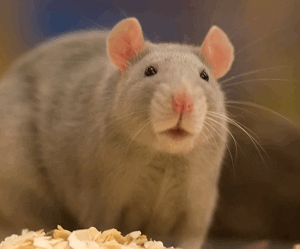
(Photo: Flickr CC Tomi Tapio)
GELLERMAN: It’s Living on Earth. I’m Bruce Gellerman. In just a few minutes, a failed experiment and an accidental discovery that could revolutionize our understanding of genetics. But first, this Note on Emerging Science from Amanda Martinez.
[SCIENCE NOTE THEME]
MARTINEZ: When a person has a stroke, every second counts. A blood clot stuck in a major artery is most often to blame. It prevents blood and oxygen from reaching the brain and cells begin to starve and die. If doctors or EMTs can’t loosen the clot quickly, brain damage becomes permanent.

(Photo: Flickr CC Tapio Flickr)
At the moment, the only way to treat a stroke is to give the victim blood thinners that break the clot apart. But new science suggests that in the future, treatment could be as simple as getting a massage.
Scientists at the University of California Irvine recently showed that it’s possible to prevent stroke damage in rats by stimulating a single whisker. The method was 100 percent effective, but had to be performed within two hours of blockage in the rat’s artery to work.
Researchers found that stimulating a lone whisker for four minutes activated the blood-deprived region of the rat’s brain. The demand for blood became so great, it caused alternate arteries to retrieve blood pooled within the clogged artery and re-route it. Imagine a crowded theater full of people trying to escape. Instead of throwing themselves at a single locked door, they suddenly find four emergency exits.
But of course, rats aren’t humans and we don’t have sensitive whiskers, so the question remains as to whether the technique could work for us. The good news, researchers say, is that our lips and fingertips serve the same essential purpose as a rat’s facial sensors. And given how dangerous and debilitating strokes can be, they believe a non-invasive, cheap, potential fix such as this might well be worth a shot.
And that’s this week’s note on emerging science. I’m Amanda Martinez.
[SCIENCE NOTE THEME]
Related link:
Read the research paper published in PLoS ONE
[MUSIC: Jason Moran “Planet Rock” from Modernistic (blue Note Records 2002)]
GELLERMAN: Just ahead , “Don’t Be Such A Scientist.” A new book teaches researchers how to communicate with the public.
OLSON: The science community is continuing to communicate today largely at the same pace as they did 20 or 30 years ago, while our society has turned into this rapid action society of people tweeting and twittering and youtube-ing and everything else like that and the profession is not keeping up with it.
GELLERMAN: Turning scientists into storytellers. Keep listening to Living on Earth!
[CUTAWAY MUSIC: Dizzy Gillespie “The Heat’s On” from Dizzy’s Diamonds (Verve Records 1992)]
Genetics and the Environment
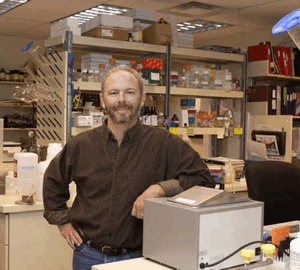
Professor Michael Skinner in his lab at Washington State University. (Michael Skinner)
GELLERMAN: A failed laboratory experiment led to an accidental discovery that is changing the way we understand genetics. It happened in Professor Michael Skinner’s lab at Washington State University. Skinner was studying DNA—the genetic code of life…when he found, by chance, that environmental factors can change the way our genes work for generations far into the future, without damaging the DNA. Professor Skinner is what’s called an epigeneticist and he joins me from Pullman, Washington. Welcome to Living on Earth.
SKINNER: Thank you very much.
GELLERMAN: So, Professor, I looked it up and ‘epi’ is Greek for ‘on or around’ and genetics means ‘source or origins.’ So epigenetics – around the source, yeah?
SKINNER: Correct. So epigenetics would be things around DNA that regulate DNA activity but are independent of DNA sequence, thus, epigenetic.
GELLERMAN: So, something’s gumming up the switch, it’s not destroying the DNA.
SKINNER: Correct, correct. And so basically, sometimes it’s the structure of the DNA, how tightly it’s coiled, or loosened up, that can actually change what genes are turned on and off. And the thing that we study the most is the chemical modification of the DNA, called methylation. A small chemical gets put on the DNA, and that can also regulate what genes are turned on and off. All of this can be influenced by the environment, has nothing to do with changing the DNA sequence.
GELLERMAN: So tell me about you experiment, what did you do?
SKINNER: So we were studying early embryonic development and the process of sex-determination- so whether you get a male or a female. And, so what we did is we exposed animals, at the time of sex determination- to a couple of environmental compounds that are commonly in the environment- one was a heavily used fungicide in agriculture and one was a heavily used pesticide. And what we found was that we did not change sex determination. So, the experiment that we did for the purpose we did it actually failed.
However, we did see an interesting observation that the offspring, the embryos that were exposed, as they became adults, developed a high rate of disease. And then there was an accident in the lab and actually one of the fellows bred those animals to make the next generation- so this would be the grandchildren of the mother that was exposed during gestation- and they also had the high level of disease. So we followed that up and took it out four generations, and had the same high level of disease onset. And, it turns out the only way that that can happen is through an epigenetic-type-process.
GELLERMAN: And, you know for a fact that you weren’t damaging the DNA or the gene?

Professor Michael Skinner in his lab at Washington State University. (Michael Skinner)
SKINNER: DNA sequence mutations occur at extremely low frequencies, usually less than 0.1 percent. And, they also occur randomly, they don’t reoccur at the same place at the same time, and so experiments would not be reproducible, and they would occur at extremely low frequencies. We see extremely high reproducible frequencies and so we knew that this was probably not a genetic mutation event.
In addition, we have actually done studies to show that we do not have an increase, apparently, in point mutations or chromosomes where the genetics does not appear to have any major affect.
GELLERMAN: Is there any population evidence to suggest, historically, that we’ve detected this happening?
SKINNER: So, almost every region of the world has different disease frequencies. So, for example, in Japan they have a very high rate of a stomach disease, and a very low rate of a prostate disease. In North America, we have a very low rate of stomach disease, but a very high rate of prostate disease. If you take someone early in life from Japan and put them in the United States, they will develop generally the North American disease frequency and have prostate disease and low levels of stomach disease. This suggests an environmental impact on disease. And so there’s a lot of epidemiology experiments like that which support that kind of concept.
GELERMAN: So give me an example of something that my mom might have been exposed to that wouldn’t have caused a mutation in me, but would have affected my genetic expression, if you will.
SKINNER: First of all, the most logical one is nutrition. There’s lots of nutritional elements that can regulate programming of the embryo and different tissues. In addition, in our society today, most people are exposed to a wide variety of environmental compounds. Whether it be the bisphenol phthalates (sp?) from the plastics, whether it be agricultural compounds like the fungicide that we used called Encloselin, most people are exposed to these types of compounds on a pretty routine basis. And so these compounds have the ability to alter the epigenetics as well.
GELELRMAN: So we should really be looking at pregnant women.
SKINNER: Pregnant women are definitely the most sensitive population for influencing the fetus’ adult onset of disease. So, yes, these early life events causing later life disease is something we need to think about more, in terms of medicine. What you are is to a large degree determined what your mother did during pregnancy.
GELLERMAN: So are there a lot of epigenticists around? I’ve gotta admit that I’d never heard of it before.
SKINNER: It is a growing field. And I think it does address a lot of our unanswered questions using genetics. For established scientists that have grown up and been trained in genetics, it is a difficult shift in their thinking to consider that there may be something else. And so I think it’s going to be more the younger generation coming in that pushes the epigenetic area.
GELLERMAN: Well, there’s a certain poetry to that isn’t there? I mean, here you are, your studies of epigentics is affecting future generations of scientists.
SKINNER: I mean, anytime you’re in a paradigm shift, there’s always some opposition and push back, and definitely it always takes time for it to integrate into that mainstream sort of science.
GELLERMAN: Well Professor Skinner, thank you very much, I really appreciate it.
SKINNER: Thank you very much.
GELLERMAN: Michael Skinner is an epigeneticist at Washington State University.
Related link:
Learn more at Dr. Skinner’s website
Don’t Be Such a Scientist

Randy Olson’s book “Don’t Be Such A Scientist” breaks down the breakdown in science communication.
GELLERMAN: Now, Professor Skinner is pretty good, as scientists go, at explaining a complex subject to the average person.
We spend a lot of time at Living on Earth trying to find researchers who can talk the talk to a lay audience…and frankly, it can be tough. Translating something as difficult as say, climate change, into an easily understood issue takes a special knack that Randy Olson says scientists need to learn.
Olson, a marine biologist turned Hollywood filmmaker has a new book explaining how. It’s called “Don’t Be Such A Scientist.” Randy Olson recently spoke with Living on Earth’s Jeff Young.
YOUNG: Well, let’s start with this odd resume of yours. How does one go from being a marine biologist to Hollywood filmmaker?
OLSON: Through the telling of stories. And, these days when I look back at the two careers, that seems to be the unifying theme. I think I was drawn into the world of science by getting to know a number of senior scientists who were incredible storytellers. And, by the late ‘80s I had gotten to the point where I’d done a lot of the major field experiences that I’d wanted to have and found myself telling lots of stories of what I had learned and the deeper I got into that the more I started experimenting with the use of film and video. And I finally realized in 1994, right about the time I got tenure as a professor in science, that I wanted to kind of branch off and go off into this different direction.
YOUNG: So what does Hollywood have to teach science?
OLSON: The key point in terms of this element of storytelling is that it is the most powerful means of broad communication and people have known that here for over a hundred years in Hollywood, and so they have really refined the process of how you put together a story into its most enjoyable elements and it’s most easily received elements. So an audience can sit there and actually not mind the information that you are trying to convey to them in the course of the story. They know how to do it, and there is so much the science world can convey to them, and will, eventually, it’s just a matter of when they ease up.
YOUNG: Well, tell me more. What are scientists doing wrong here?
OLSON: They are so focused on just getting the facts and only the facts and putting them in there and getting all of the information in, at all costs, that it handicaps their ability to tell a good story, number one. And number two- they just simply don’t put a priority on making sure that they are telling a well structured story. And number three- over the ages there has developed this phobia about the word ‘story.’ They have come to equate those words with dishonesty, and that’s not the case. The challenge is to tell stories that are 100 percent accurate. That is exactly the message of my book.
YOUNG: Give me a couple of examples of what you hear scientists doing wrong and where they might benefit from looking to, of all places, Hollywood.
OLSON: Well, for starters, as one of my screenwriter friends said, they bury the lead. Just as a silly little example of that, last spring I ran a workshop where we had a bunch of scientists send us their videos of videos that they’re making in their labs, and one group sent this video of deep sea creatures- which they had 40 deep sea creatures- and in the middle of all of these little clips, all of a sudden there was a photo of this long, thin, eel-like fish and then a shot of 12 men on the dock holding this thing up.
And, that photo of 12 men holding up this fish- it’s the longest fish in the world, ever been discovered- and yet, the people putting together the video didn’t think it was any different than the weird little sea cucumbers, slugs and stuff that they had in the other shots, and they were seeking my input, and I said, “Start your video with that! That turns people’s heads. That’s fascinating!”

Randy Olson’s book “Don’t Be Such A Scientist” breaks down the breakdown in science communication.
YOUNG: But just prioritizing and finding the more interesting nuggets- that alone can’t explain why science seems to be getting its head handed to it over and over, for example, in the climate debate. What’s going wrong there?
OLSON: There’s this element of speed that is not built into the system and the science community is continuing to communicate today largely at the same pace they did 20 or 30 years ago, while our society is turning into this rapid-action society of people tweeting and twittering and youtub-ing and everything else like that and the profession is not keeping up with it.
The science world, I mean, the clearest example of what happened as a consequence of that is what went on last November with the climate-gate debacle where somebody in the UK stole 1500 or so emails from climate scientists and immediately set to work spinning what that material was about into a big story for the media. And, as this all erupted, the science community just sat there in, more or less, in shock, just watching it.
YOUNG: Well, ok, so if a scientist caught up in that so-called ‘climate-gate’ episode, had read your book, and, was thinking about applying the lessons from Hollywood, what should the scientists have done there in response?
OLSON: They should have taken the initiative by, first off, telling the story in their own terms. And, the story began with the fact that the law was broken. People broke in, illegally, to a computer and stole emails. I will say again the number one priority is the telling of stories and the structuring of information. And, it’s the logical flow, it’s the narrative development, and it’s the ability to tell the story all the way from ten pages down to one page, down to one paragraph, down to a single sentence.
And, you know, that’s the idea of high concept in Hollywood, is the ability in a single sentence to tell the very complex story that springs to life and lights a fire in the mind of the person. And, you know, as I mentioned in the book- Snakes on a Plane. That’s all it takes for you to see a scenario that has urgency to it and you can envision people dealing with that.
YOUNG: So, what’s the high concept for climate change, then? What’s your elevator pitch?
OLSON: We’re all going to die. (Laughs).
YOUNG: (Laughs) Oh boy! But you’ve got no sequel!
OLSON: (Laughs) Truly.
YOUNG: You know, reading your book, I had a negative reaction not so much to what you were saying, but to what it implied about us, the audience receiving the science information, that we need some song and dance from scientists. Shouldn’t it be enough and doesn’t it say something bad about us on the receiving end of this information that we can’t just be happy with scientists doing science, and telling us the science?
OLSON: I think the ironic thing with story telling is that once upon a time it was the most powerful means of mass communication. And then, in the ‘80s and the ‘90s during the information explosion there was an era where people were questioning, you know, is story telling dead and over with. And, I think it’s now undergoing a rebirth. Where, it’s now, in the middle of all this chaos, it is the beacon of clarity of all these people that can get up there and tell us this information in a structured format- in the form of a story telling.
It’s unfortunate, you know, I wish we lived in a world where you didn’t have to bother with communications, where you could open your mouth and speak the facts and they would be golden, but we’re not in that world, we’re in the United States of America.
YOUNG: Randy Olson, thanks very much.
OLSON: You betcha.
Related links:
- A review of Randy Olson's movies "Flock of Dodos." The movie looks at intelligent design advocates’ challenge to the science of evolution.
- Climategate articles from the NYTimes shows a breakdown in science communication
- Report by Penn State that basically cleared them
- Climategate article from New Scientist
[MUSIC: George Clinton “Lickety Split” from Plush Funk (George Clinton Enterprises LLC 2005)]
GELLERMAN: Randy Olson is author of “Don’t Be Such A Scientist.” He spoke with Living on Earth’s Jeff Young.
Still Life
KLINKENBORG: Every now and then I feel as though I've woken up in a Rembrandt etching – a low, tangled thicket of pen-strokes from which a landscape emerges.
GELLERMAN: Commentator Verlyn Klinkenborg.
KLINKENBORG: It's not so much that the sky has taken on the tint of seventeenth century drawing paper, or that the world has lost its color. It has more to do with the balance of time. I wake up and nature seems to have paused in expectation. There’s a numb overcast overhead with little drift to it. Wood smoke slides down the roof and onto the road, the wild apples are waiting to fall.
We are all inked in, caught in the moment. It’s an appealing illusion. I imagine being the human caught in one of Rembrandt’s landscapes, that small figure standing in front of what looks like a cross between a house and a haystack. He is resting from something. Perhaps he is even looking out from his garden at the artist working in the distance. It took no more ink to draw that figure then to write out a simple equation. And yet, there’s no mistaking his posture or the moment he’s given himself to rest, though that moment has now lasted since 1645. That’s how it felt this morning- as if time had simply stopped.
A crow had paused in the pasture. I counted 15 morning doves, resting on a power line. The leaves that were about to fall had fallen, and the oaks were not about to relinquish theirs. The weather seemed to be waiting somewhere off to the west. A flight of birds stirred from the branches, and then settled back, almost immediately. I heard what sounded like a small dog barking in the distance, and realized it was a flock of geese beyond the tree line. They never came into view. Before long the breeze will stir and rain will begin to fall. The silent anticipation hidden in such a quiet morning will be forgotten.
The cry of a red-tailed hawk will unsettle the morning doves and one by one those wild apples will become windfall. And, as the weather changes and the clock resumes its ticking, I’ll have to free myself from the artists’ ink before it dries completely. Step outside and walk over the hill toward the sound of those distant geese.
GELLERMAN: Verlyn Klinkenborg lives on a farm in upstate New York. He’s an editorial writer for the New York Times.
[MUSIC: Vince Guaraldi “Autumn Leaves” from Essential Standards (Concord Music 2009)]
GELLERMAN: You can hear our program anytime on our website, or get a download for your MP3 player. The address is L-O-E dot org. That’s L-O-E dot O-R-G. There you’ll also find pictures and more information about our stories. And, we’d like to hear more from you. You can reach us at comments at L-O-E dot org, once again, comments at L-O-E dot O-R-G. Our postal address is 20 Holland Street in Somerville, Massachusetts 02144. And you can call our listener line at 800-218-9988, that’s 800-218-9988.
Coming up – Giant Walmart shrinks the distance from field to fork, and a thatcher expands the use of field to rooftop. Stay tuned to Living on Earth.
[CUTAWAY MUSIC: Dizzy Gillespie “Con Alma” from Dizzy’s Diamonds (Verve Records 1992)]
Giant Walmart Thinks Small

The superstore Walmart is considering buying food from local farms. (Wikipedia Creative Commons)
GELLERMAN: It’s Living on Earth, I’m Bruce Gellerman. Walmart is the largest retailer in the world. Last year, its U.S. revenues alone were a quarter of a trillion dollars …and half of that came from selling food.
Now, the big box seller is starting to think small. Walmart has announced a new strategic sustainability initiative to help small and medium size farms not just survive but thrive. Environmental groups including World Wildlife Fund, Conservation International and Rainforest Alliance are working with Walmart to design the company’s program and monitor its progress. Michelle Harvey is a project manager at Environmental Defense Fund. EDF is one of the groups also working with Walmart. Ms. Harvey, welcome to LOE.
HARVEY: Thank you, glad to be here.
GELLERMAN: So, let’s talk about this deal. Big deal, big company- what are they trying to do?
HARVEY: What they’re going to do is expand to a greater number of locally grown farms. They’re looking for opportunity to increase the number of farmers, the types of food that the farmers are growing and to really increase the diversity of sources that they have for the food that they sell in their stores around the world.
GELLERMAN: So what is the specific goal in terms of the amount that they are going to be sourcing from small farmers?

Michelle Harvey worked with Walmart to develop their sustainable agricultural platform. (Photo: Michelle Harvey)
HARVEY: In the U.S., they’re looking to increase that number to about nine percent. It essentially is to double the amount of produce that they are purchasing locally. In the United States, for instance, it’s within a state’s boundaries.
GELLERMAN: And, it’s not just the United States, this is a global initiative.
HARVEY: Walmart spent about 18 months really working with organizations like Environmental Defense Fund, but also with their sustainability teams in the countries where Walmart is located around the globe. And, this effort really was looked at in a global perspective, so it will be happening in Brazil and Argentina, Japan and China, as well as in the US.
GELLERMAN: Different goals, different countries?
HARVEY: Same large goals, different implementation. For example, in Brazil, which is one of the key areas where cattle raising has resulted in a lot of deforestation, there’s a very targeted goal to only source beef in areas that can be certified as not causing harm to the tropical forests down there.
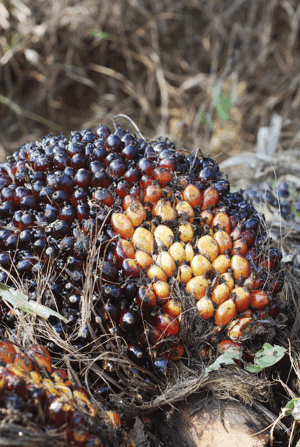
By 2015, Walmart will require that all of the oil palm for its store brand products be grown sustainably. (Wal-Mart)
GELLERMAN: How many farmers do you think they will be able to pull into this program?
HARVEY: The goal over the next five years is to engage somewhere in the ballpark of a million or more farmers.
GELLERMAN: So, Ms. Harvey, what’s in this for Walmart? What do they get out of it- why bother with so many local farms and farmers?
HARVEY: Walmart stands to get several things out of it. First and foremost, they get fresher food, which usually sells better with their customers. They have more diverse supply, which means if there’s a freeze in one part of the country they’ve still got a good opportunity to purchase a product without having to see the prices increase. It’s also about traceability. You know where your food is coming from if there’s a problem, as we’ve seen happen with e-coli over the last few years. It- much more quickly able to identify the source and address it. So, it’s better food, and it’s reduced risk.
GELLERMAN: Walmart is so enormous, this project will make them even larger, give them an even larger share of the market. Could that drive down the prices that they pay their farmers even further?
HARVEY: The goal of the project is to make harvest of food more efficient. But Walmart has expressed a strong commitment to leaving more of the profit with the farmer, which means the people today who might help to get the food from the farm to the store, are more likely the area where Walmart is going to look to become more efficient.

The superstore Walmart is considering buying food from local farms. (Wikipedia Creative Commons)
GELLERMAN: What’s good for the consumer, in terms of low prices and Walmart, in terms of market share, might not necessarily be good for farmers.
HARVEY: That’s the part that will be the most interesting in all of this. In the framing of the goal, the big question that was discussed was how do you help the farmer to get the prices he needs to support his family or her family- a lot of the farmers that Walmart will be looking to work with are actually women- but how do you keep the farm family well funded so that they stay in farming, and still maintain a good price. I think a good chance of what will happen is that more direct relationships will develop between farms and local stores. That’s going to help to give more money to the farmer but without so many middlemen, you may still actually see lower prices without it actually hurting the farms themselves.
GELLERMAN: Well, kind of win-win-win.
HARVEY: Well, there’s going to be folks in that supply chain who are going to fall out, a little bit. But I think for the planet, looking at the environmental impacts and then being able to help educate the farmer on how to farm in a better way, keeping farm families economically healthy, and then providing fresh food to the community, could- it has the potential to do a really, a really positive thing for how we produce our food.
GELLERMAN: Of course this is a promise. This is a project with a promise. Who is going to hold their feet to the fire?
HARVEY: One of the roles the NGO partners like EDF play are to really make sure that its implemented well, that the goals are really accomplishing what they say they’re accomplishing, and if they’re not, to help figure out why not and what we can do, suggest that Walmart do differently. Our expectation is that we will probably get about three years into this initiative, learn what’s working and what isn’t, and the goals will probably shift as they move forward. But, we’re optimistic that it’s all going to be pointed in the right direction to benefit the communities and to benefit the planet.
GELLERMAN: Michelle Harvey is project manager with Environmental Defense Fund, helping Walmart with its new ‘Global Ag Sustainability’ Program.
[SOUNDS OF SHOPPING MARKET]

Davis Square farmer’s market in Somerville, MA. (Photo: Honah Liles)
GELLERMAN: But, what about the smallest of the small farmers? Growers like these –farmers who do a brisk business selling rainbow chard, organic kale, and heirloom tomatoes at the weekly farmers market near our studios? I went shopping for opinions to find out if they think they’ll benefit from the Walmart initiative.
GELLERMAN: Uh, can I have two pounds of your honey-crisp apples please?
WADLEY?: Yes, you may. Do you want me to pick them out or do you want to pick them out yourself?
GELLERMAN: Uh, I’ll get ‘em, thanks.
WADLEY?: Yeah, here’s a bag, it will be about six apples… I’m Dan Wadley (sp?), and I’m a grower for Kimball Fruit Farm in Pepperell, Massachusetts.
GELLERMAN: Walmart is proposing that they greatly expand the amount of local produce and products that they buy from small farmers like yourself. Do you think that’s a good idea, would that be good for you guys?
WADLEY?: We grow and sell just what we can at our famer’s market and at our farm stand. So, for us it really won’t affect who we are or what we do. We’re just the right size for what we do.
[SOUNDS OF SCALE]
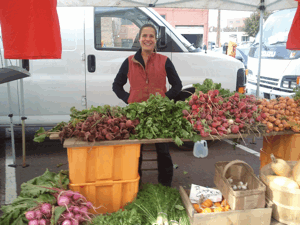
Farmer at the market. (Photo: Bruce Gellerman)
KIMBALL: My name is Ellery Kimball. I run Blue Heron Organic Farm in Lincoln, Mass. Small farms just don’t make much quantity. And it must be hard for small farms to supply a store or a chain of stores as big as Walmart.
GELLERMAN: Philosophically, would it be a good idea? I mean, here you are one of the smallest farmers in the country and they are one of the biggest retailers in the world.
KIMBALL: I think it’s better for consumers to go directly to the farms and to develop a relationship with the farmers- that way they know exactly what is going into their food and what is being used. So, when people come to my farm they know that we are not using pesticides or herbicides or fungicides. They know exactly what my farming practices are, and they get to interact with the place and get a better connection with their food. I think if they go to Walmart, they’re losing that farm-to-table connection, and I think that’s a sad thing.
HANSON: My name is Matt Hanson, from Hanson’s Farm in Framingham. We have a small, about 80-acre farm.
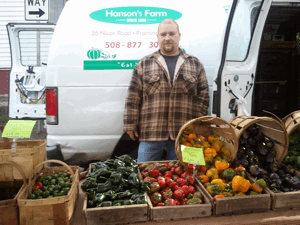
Farmer at the market. (Photo: Bruce Gellerman)
GELERMAN: So what do you think of the Walmart deal?
HANSON: It depends. It depends on how they treat us, because they could really destroy us with wholesale prices. For example, the wholesale price of corn this year was 13 cents and ear, and you can’t really make a living off of 13 cents an ear, no matter how much you sell. So, if they can keep up with regular grocery store prices for wholesaling, that’s fine. But if they can’t then I don’t think it’s a good idea.
GELLERMAN: They’re big.
HANSON: They’re huge! They can totally destroy a small farm, a whole bunch of small farms. Excuse me for one second….thank you very much …
[SCALE SOUNDS]
GELLERMAN: Thoughts about Walmart’s new Ag Initiative from small growers at the Davis Square farmers’ market in Somerville, Massachusetts.
Related link:
Wal-Mart’s Sustainable Agriculture Fact Sheet (PDF)
[MUSIC: Echo And The Bunnymen “In The Margins” from B Sides And Live 2001 – 2005) (Cooking Vinyl 2007)]
Creating a Thatched Roof

Architect Keith Malcolm Brown transformed a suburban ranch into an Irish thatched roof cottage. (Photo: Bruce Gellerman)
[SOUND OF CRUNCHING GRAVEL]
GELLERMAN: A gravel road leads to a glade in the forest here in Lincoln, Massachusetts, an affluent suburb just west of Boston.
[ANIMAL SOUNDS]
GELLERMAN: It’s a storybook setting-- light filtering thru a widening break in the trees, blue sky, fluffy white clouds, and farm animals scurrying and squawking about.
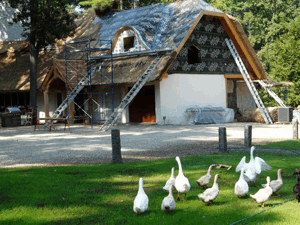
Making a flap over a new thatched roof. (Photo: Bruce Gellerman)
BROWN: One of the benefits of the job is that we’ve been getting fresh eggs whenever we come out to do an inspection or add a drawing…
GELLERMAN: Keith Malcolm Brown is principle owner of Period Architecture. He specializes in blending traditional styles with designs that fit modern desires. His latest commission calls for transforming this 1950s suburban ranch into a Irish country cottage- complete with thatch roof.
BROWN: This is the largest private residence that has a thatched roof in New England.
[AMBIANCE FROM AREA AROUND THE HOUSE]
GELLERMAN: It looks like a place that the hobbit could live in.
BROWN: Well that’s kind of a nice image. It’s in a setting that’s surrounded by woods. There are chickens and ducks and geese. And, we were looking for something that would kind of epitomize a comfortable place to live.
GELLERMAN: The windows look like mushroom caps.
BROWN: Yes, called eyebrow windows. They’re kind of a traditional window on this kind of house. And, because it’s thatch, you can do curves quite easily. The challenge was learning about the material. There’s about 15 acres of reed on the roof.
GELLERMAN: This is architect Keith Malcolm Brown’s first thatch house and working with the material is a steep learning curve. Thatch is a renewable resource and has great insulating properties or R value.
BROWN: The thatch is a foot thick, so we’re up to about R80 at least. And with some sections with the roof up to R90, R92.

Architect Keith Malcolm Brown transformed a suburban ranch into an Irish thatched roof cottage. (Photo: Bruce Gellerman)
GELLERMAN: Literally, through the roof!
BROWN: It’s exceptionally high. I know of no other structure that would have this kind of R value. And, we’ve raised the roof to 45 degrees from about 14 and a half degrees because you need that for the pitch of the thatch. It needs to shed water- there are no gutters on thatched house, so it needs to push the water down and away from the house.
[SOUND OF THROWING BUNDLES]
GELLERMAN: Workers toss bundles of imported Turkish Water Reed into the air. It’s like building a field on top of a house. Grasses and reeds have been used as building materials for thousands of years and thatch structures can be found on every continent except Antarctica. We have plenty of thatching material here in the United States. It’s an invasive plant called phragmites, but it’s not cut commercially.
Where do you find someone who does thatching these days?
BROWN: Ah, you go on the web like you do for everything else. And we found Collin McGee- thatching dot come.
[SOUND OF GELLERMAN CLIMBING THE LADDER]
GELLERMAN: Can I talk to you?
I climbed a ladder, and betwixt and between roof and ground, I found master thatcher Colin McGee….
Well, I’m Bruce!
MCGEE: Colin, nice to meet you.
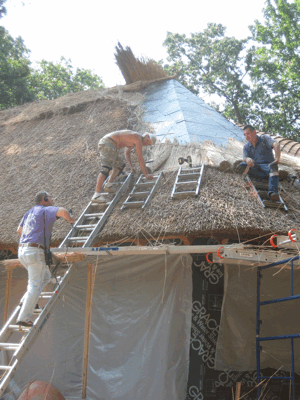
LOE’s Bruce Gellerman climbs up to meet Master thatcher Colin McGhee. (Photo: Dick Williams)
GELLERMAN: Sure footed on the steep roof Colin McGhee holds well worn tools of the thatching trade in hand: a curved metal knife and a flat wood hammer.
[SOUND OF THATCHING]
MCGEE: It’s called a leggett, it’s what you put the reed on the roof with. It just catches the ends of the reed. So it looks all cut, but actually, it’s dressed in that position. I’ve been thatching since 1977, and thatching in America since 1991.
[SOUND OF THATCHING CONTINUE]
GELLERMAN: How did you become a thatcher?
MCGEE: Well, my parents are Scottish, so we used to do this Scottish tour every year and Robert Burns’ cottage was being thatched. That was just stuck in me head when I was about seven, and I got, sort of, asked to leave school at 16, and as a joke I said I wanted to be a thatcher. And the next thing I knew, I got a list of thatchers in southeast England, wrote to several, and got a job with one. So that’ll teach me! (Laughs).
GELLERMAN: So, what’s the benefits of this stuff?
MCGEE: Well, it’s aesthetically pleasing, it lasts a long time.
GELLERMAN: How long will this last?
MCGEE: Uh, 50 years. It’s a great insulator, it’s a natural product, it’s quite sound. It’s just nice living under a thatched roof. You’ve got a foot thick whole lotta reeds, it’s incredible. It’s like a giant jigsaw puzzle. Each reed is a different shape so you want different shaped and sized bundles for a particular part of the roof. Like in a valley, you use big bushy topped stuff, on a hip like here, you want nice triangle, tapered reed. So if you get the right bundle for the right part of the roof, it makes it very easy.

Master thatcher Colin McGhee. (Photo: Bruce Gellerman)
GELLERMAN: What are the challenges for you thatching here, in the United States?
MCGEE: Well, the climate is a lot different, so you’ve got to adjust your thatching techniques to suit the climate. It’s a lot more humid here and so the roofs wont’ last as long if you use the same techniques. You leave the surface of it open so it dries out quicker instead of putting it all on super tight. But mainly the reed, you use the toughest, ugliest reed you can get instead of the finest, prettiest, which you’d use back home.
GELLERMAN: Is there a growing demand for this type of material or this building style?
MCGEE: Well, hopefully. You know, no one’s building subdivisions like they do in Holland and in Germany. You know, they build whole hundreds of houses with thatched roofs.
GELLERMAN: Today?
MCGEE: Yeah, it’s just classed as another, it’s nothing weird, it’s just another roofing material.
[THATCHING SOUNDS]
GELLERMAN: How long will it take you to do this roof- finish…start to finish?
MCGEE: It’s a two month job. And the next job is a pub up in New Hampshire- Epping so it’s not too far away…
GELLERMAN: Master roof thatcher Colin McGhee. For photos of the him, the thatched home and architect Keith Malcolm Brown head to our website: L-O-E dot O-R-G.
[THATCHING SOUNDS]
Related links:
- McGhee & Co. Roof Thatchers
- Visit the Boston Design Guide
[MUSIC: Anouar Brahem “The Astounding Eyes Of Rita” from The Astounding Eyes Of Rita (ECM Records 2009)]
GELLERMAN: On the next Living on Earth, a group of Harvard undergrads design a battery that’s a real kick.
[KICKING SOUND]
HARVARD STUDENT: So right now you need about 15 minutes of kicking the ball that allows us to use a single LED- it'll be lit for about 3 hours.
GELLERMAN: Using soccer to light up the world – a noble goal, next time on Living on Earth, and also on our online sister show, Planet Harmony. Planet Harmony invites all, but has special appeal for young African Americans. Join the discussion at My Planet Harmony dot com.
[SOUND OF COW MOOING]
GELLERMAN: We leave you this week in a Scottish Glen.
[SOUNDS FROM: Margoschis “Scottish Glen” from Wild Britain (The British Library Board 1997)]
GELLERMAN: Nighttime, Inverness, Scotland. The air is brisk and already there’s snow on the ground. October is the beginning of the rutting, or mating season, for these Red Deer stags. Richard Margoschis recorded their roars against the background of a river. The audio can be found on the British Library National Sound Archive CD called “Wild Britain.”
[SOUNDS OF A SCOTTISH GLEN]
GELLERMAN: Living on Earth is produced by the World Media Foundation. Our crew includes Bobby Bascomb, Eileen Bolinsky, Ingrid Lobet, Helen Palmer, Jessica Ilyse Smith, Ike Sriskandarajah, Mitra Taj, and Jeff Young, with help from Sarah Calkins, Sammy Sousa, and Emily Guerin. Our interns are Nora Doyle-Burr and Honah Liles. Jeff Turton is our technical director. Alison Lirish Dean composed our themes. Steve Curwood is our executive producer.You can find us anytime at L-O-E dot org. And check out our Facebook page, it’s PRI’s Living on Earth. I’m Bruce Gellerman. Thanks for listening.
ANNOUNCER: Funding for Living On Earth comes from the National Science Foundation supporting coverage of emerging science. And Stonyfield farm, organic yogurt and smoothies. Stonyfield pays its farmers not to use artificial growth hormones on their cows. Details at Stonyfield dot com. Support also comes from you, our listeners. The Ford Foundation, The Town Creek Foundation, The Oak Foundation—supporting coverage of climate change and marine issues. The Bill and Melinda Gates foundation, dedicated to the idea that all people deserve the chance at a healthy and productive life. Information at Gates foundation dot org. And Pax World Mutual Funds, integrating environmental, social, and governance factors into investment analysis and decision making. On the web at Pax world dot com. Pax World for tomorrow.
ANNOUNCER 2: PRI – Public Radio International
Living on Earth wants to hear from you!
Living on Earth
62 Calef Highway, Suite 212
Lee, NH 03861
Telephone: 617-287-4121
E-mail: comments@loe.org
Newsletter [Click here]
Donate to Living on Earth!
Living on Earth is an independent media program and relies entirely on contributions from listeners and institutions supporting public service. Please donate now to preserve an independent environmental voice.
NewsletterLiving on Earth offers a weekly delivery of the show's rundown to your mailbox. Sign up for our newsletter today!
 Sailors For The Sea: Be the change you want to sea.
Sailors For The Sea: Be the change you want to sea.
 The Grantham Foundation for the Protection of the Environment: Committed to protecting and improving the health of the global environment.
The Grantham Foundation for the Protection of the Environment: Committed to protecting and improving the health of the global environment.
 Contribute to Living on Earth and receive, as our gift to you, an archival print of one of Mark Seth Lender's extraordinary wildlife photographs. Follow the link to see Mark's current collection of photographs.
Contribute to Living on Earth and receive, as our gift to you, an archival print of one of Mark Seth Lender's extraordinary wildlife photographs. Follow the link to see Mark's current collection of photographs.
 Buy a signed copy of Mark Seth Lender's book Smeagull the Seagull & support Living on Earth
Buy a signed copy of Mark Seth Lender's book Smeagull the Seagull & support Living on Earth

